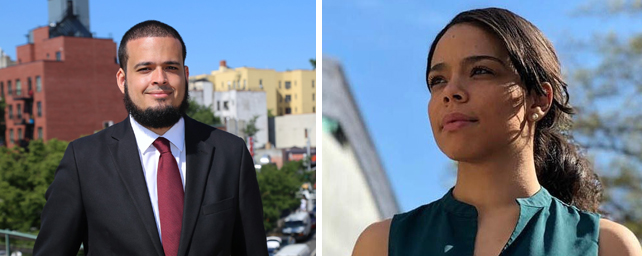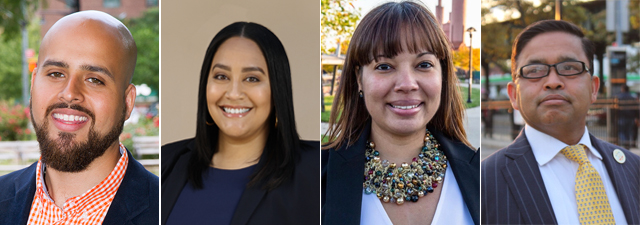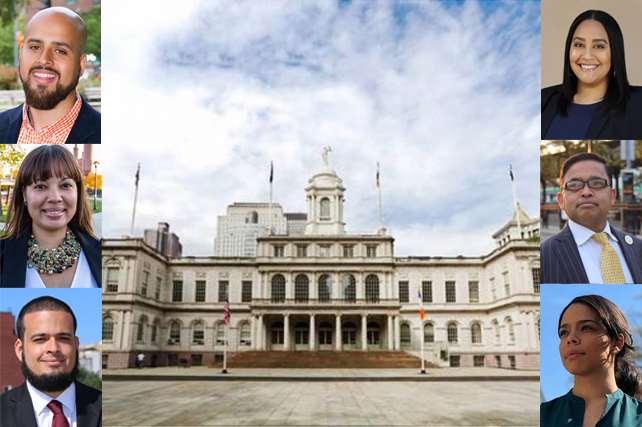Does the Boogie Down want bike lanes? Districts 14 and 18 have a number of options for candidates who Bronxites interested in remaking the the streets as safer and more welcoming for more transportation modes than just the private car. Good thing there's ranked choice voting!
In the 14th, a former planner for the Regional Planning Association and a DSA-endorsed community organizer both told Streetsblog that they're ready to reallocate street space to get the ratio rate right in a district where 72 percent of households don't own cars yet there's somehow a dearth of protected bike lanes.
And in District 18, four candidates said it's time to give southeast Bronx residents better options than just driving everywhere, especially as the city starts to introduce scooter share and the MTA moves forward on plans for new Metro-North stations in the district.
District 14 (Claremont Village, Fordham, Kingsbridge, Marble Hill)

District 14, represented by the term-limited Fernando Cabrera, has six candidates vying to replace him:
- Pierina Sanchez, Senior Advisor for Housing, Economic Development and Labor in the de Blasio Administration
- Adolfo Abreu, Organizing Director, Northwest Bronx Community and Clergy Coalition
- Fernando Aquino, adjunct professor, Lehman College
- Haile Rivera, Founder and Executive Director of Hands On New York
- Yudelka Tapia, Democratic district leader
- Socrates Solano, Community Relations and Outreach Coordinator at UnitedHealth Group
The district, stretching over the neighborhoods of Claremont Village, Fordham, Kingsbridge, Marble Hill, Morris Heights, Mount Eden, Mount Hope, and University Heights, is relatively transit-rich for the Bronx, thanks the presence of the D train, the 4 train, multiple bus routes and a pair of Metro-North stations. But there were still more than 2,000 injuries on the road in 5,304 reported crashes in 2019 and 2020 (roughly seven crashes per day!), which indicates street design that hasn't gotten out of the last century even in an area that's as perfectly positioned for it as anywhere in the city.
Sanchez, who talks about creating streets centered around pedestrians and cyclists on her website, is a lifelong resident of District 14 and has used that experience to come to her point of view honestly.
"The the painful part about what it's like on the ground in District 14 is when you walk around, and I love my people, but it's very aggressive New York driving," Sanchez said. "And these streets are not not designed to really put a curb on that. We don't have traffic calming devices, we don't have a lot of pedestrian islands, we don't have enough green in the streets or enough interventions that make make for a better pedestrian experience."
For Sanchez, the way to get those interventions, and to get more east-west bike lanes or make it physically impossible to make a U-turn on Fordham Road, is through effectively organizing the area community boards.
"I believe our community boards are an asset in the city of New York. Yes, we know that they're not representative, that renters are underrepresented, lower income people are underrepresented, pedestrians and transit users are underrepresented. So I want to do everything that I can to strengthen our community boards to increase interest in them and applications," she said.
Sanchez, who was endorsed by StreetsPAC, said her door-knocking efforts has put her in touch with plenty of people who kvetch about parking in a neighborhood where so few households have cars, but she said she feels like she's positioned to be a kind of representative who can guide conversations on street policy in the direction of safer streets.
"If we start conversations about, 'Look on this one stretch of the Grand Concourse last year, we lost six lives. And that is because our streets are designed so that the cars zoom by you. And if you just so happen to make a quick mistake, and step onto that onto that road bed without looking, that car will not have been going at a speed to prevent your death.' If we start our conversation with 'look at the risks we're talking about' and 'look at what happened in this neighborhood or in that neighborhood that got XYZ kind of intervention,' then I think the conversation takes a different tone. People need space to to express their concerns and say what they need to say about how important their parking spots are, but we also need to give space for that factual basis of what's happening right now," she said.
Abreu, whose Transit Democracy platform includes things like increased DOT funding for bus and bike priority projects and free public transit, is part of the Democratic Socialists of America's slate of six endorsed candidates. He said that if the Bronx is going to get its fair share of safe streets, a new generation of leaders needs to support and push the DOT to get new pedestrian, cycling and bus improvement projects past entrenched opposition.
"When it comes to the Bronx, I think we need leadership that can support the agency because more often than not, we have community boards or other groups that heavily resist these type of projects," he said. This potential new generation of council members one of the biggest things we have to do is support DOT and hold them accountable to the implementation of these projects, so that they don't give into pressure for those folks who don't want to see this vision be being enacted."
And as a community organizer, Abreu pitched himself as being able to break through to people who aren't always part of the street safety conversation.
"I'm pretty sure there's a lot of people in our neighborhoods, who if we actually apply our practices as community organizers and reach those who are not in these traditional spaces, we'll actually find more people who might be open to this idea and this vision of how do we make our communities healthier by reducing our reliance on cars?" he said.
Abreu said he'd heard complaints from residents that new development could potentially mean more cars and less parking for then, but he didn't say head on whether he was in favor of the end of parking minimums for new developments. He did say he wanted to rethink the concept though.
"If we're talking about parking minimums, we should actually talk about minimums for bike racks or scooter parking. How do we apply pressure or maybe incentivize developers to make something that's free of charge, that's connected to you being able to live in this building, and provide that ease of access for folks to rely more on public transportation and bikes? So we may build parking lots with new developments, but that doesn't mean everybody has a vehicle. If we actually change your calculus, and actually push for bike racks as part of these new buildings going up, I think it would be much better for us, while we think about how to more proactively reduce this reliance on cars that we have," said Abreu.
District 18 (Parkchester, Hunts Point, Soundview)

District 18, represented by the retiring unrepentant homophobe Ruben Diaz Sr., has six candidates vying to be the next person to lead residents of Castle Hill, Parkchester, Morrisania, Hunts Point, Melrose, Longwood and Soundview. The contenders are:
- Amanda Farias, State Committeewoman for the 87th Assembly District
- Darlene Jackson, former Project Coordinator at the Women's Community Justice Association
- Michael Beltzer, former Field Manager, Lauren Underwood for Congress"
- William Rivera, District Manager for Bronx Community Board 9
- Mohammed Mujumder, President, Bangladeshi American Community Council
Diaz Sr. didn't distinguish himself by making the district's streets a safe place to be. In 2019 and 2020, there were 5,125 reported crashes in District 18 (more than six per day!) that resulted in deaths to four cyclists and four pedestrians and more than 1,700 injuries to all road users.
Beltzer, who highlights the fact that more than half of Bronx residents boroughwide don't own a car, put it bluntly when confronted with the numbers.
"That shows an abject failure," he said. There basically is very little safe street infrastructure in the district. We did get some improvements along Westchester Avenue, with pedestrian pedestrian islands and, and plazas. but outside of that and a few a few road diets, which were just paint there's nothing. And I think it's it's a public health issue, when 10 people have died, who didn't need to die."
Beltzer's plan to fix that failure in his two-year term?
"What's realistic is to get a bus lane on White Plains Road, and to get protected bike lanes on at least one of, if not all three of Westchester, Castle Hill, and White Plains Roads. Especially since we're getting the scooter share in 2022 that will definitely, I think open a lot of people's eyes. When you're sitting waiting for the bus, and then you see someone going buy a bike or scooter or micro-mobility device, and you're just sitting there you might say, 'I could have one of those.' I think once people feel like it's safe to ride, and there's protected bike parking and on-street bike parking, people can also feel like, 'Hey, I can leave this and it won't get stolen,'" he said.
For Farias, who was endorsed by StreetsPAC, one of the biggest impediments to cutting down on car use in the district is the fact that the 18th is a two-fare zone (something she highlights on her platform along with municipal control of the bus system), and making the NYC Ferry stop (one of the few in a low-income neighborhood) more accessible for residents of the south Bronx by working to get them some kind of transfer from the existing mass transit options in the district.
"Right now people have to pay to get on the bus and then pay to get on the ferry, which limits the amount of people that actually get to utilize it, because they are paying twice," said Farias. "So either having a transfer available for people to utilize from bus to ferry, or having a shuttle bus that goes down there to bring people to the ferry for free or a fee [that goes to the ferry price] would be great."
Farias also said that she wants to see e-scooter and Citi Bike racks bloom in the district, especially if the racks can be put near the 6 train stops in the district or the upcoming Parkchester and Hunts Point Metro-North stations that are being built as part of Penn Access.
"Every morning before the pandemic when I used to commute to work, I would take a 15 minute walk to the East 180th train station because the trains on my side are only going down the east side of the city and I would have to do a lot more transfers to get to Chelsea. So being able to have Citi Bike or an e-scooter are two different ways that could make my commute a lot quicker, but also give me access to another train route on the other side of Manhattan," she said.
While the MTA has yet to talk about exactly what the fare structure will be when it comes to intracity travel on the upcoming stations, Farias said she'd push for a type of Fair Fares, free subway transfer or other cheaper option for Bronx commuters coming down to Penn from the new stations.
There's a push and pull that has to happen with the installation of protected bike lanes, according to Farias, which she did express support for. Suggesting that the district's car reliance won't be fixed immediately, she said that parking that's taken away should be somehow reallocated, possibly in the form of municipal parking garages.
"Because we are still a very car heavy community at times, I would like to see the city move towards some municipal parking lots and some of the areas throughout the Bronx. I don't think a municipal parking lot where you have to pay per hour is going to encourage people to get more cars. I think things like the Metro-North stations are going to encourage people to move into communities, and change the dynamic of what that community looks like if we're not building infrastructure or systems for the communities that are already here," she said.
Jackson, a longtime advocate who's worked with Riders Alliance and highlights her support for the transit advocacy world's 2021 Transit Equity Agenda on her website, said that she would work to make sure the activists she's worked with kept up a presence in the district if she was elected.
"The fact is that I come from the world of grassroots organizing, so I would definitely make sure I'd continue the relationship with that the people who have aught me, the folks that I'm a member with, those are the folks who are who's on who's on the front lines actually doing the advocacy and organizing work," Jackson said. "So I want to make sure that that they have a presence in my council district, and make sure the people in my district are involved and aware. This is how you build power."
What that means as far as what she'd fight for in the transportation realm is that she'd try to move fast and prioritize the people that too many community boards don't put at the front of the conversation.
"When there's pushback about we're going to lose parking spaces, well, fifty percent of the people who live here aren't worried about a parking spaces, they're worried about how to get to a bus or a train. We have to make sure that people are receiving information in a timely manner, to make informed decisions on the best interest of all residents of this district, and not a select few," she said.
Jackson specifically pointed to the long process to get to a proposal for a Story Avenue bus lane, which she said sapped public enthusiasm for the idea.
"Story Avenue is a bus lane that's supposed to be implemented within our district and is something that that was part of the Bronx bus network redesign going back to 2018 or 2019. But when it was time for the DOT to present at the local community board about the update, the feedback they received from those workshops that were held to get feedback from the public, the community board has almost forgotten that this actually happened," said Jackson.
For Mujumder, there was one big idea that he said the city and state have to embrace in order to fix the problem of interborough transportation.
"We have a rising population of Bangladeshi Americans, and those people are [culturally] well-connected with Jackson Heights, but there is no bus route to connect them," he said. "In order for them to go to Jackson Heights, they have to take the train first and it takes two hours to reach just two or three miles. So if we have a bus route, designed from Parkchester to Jackson Heights, that will be a huge benefit in safety and time and will really help people a lot."
Several candidates did not respond to interview requests. Many of the candidates from the special elections in March in District 11 and District 15 are on the ballot in the primary. Find their street safety positions here and here. The election is on June 22. Early voting began on June 12. Click here for more information.






